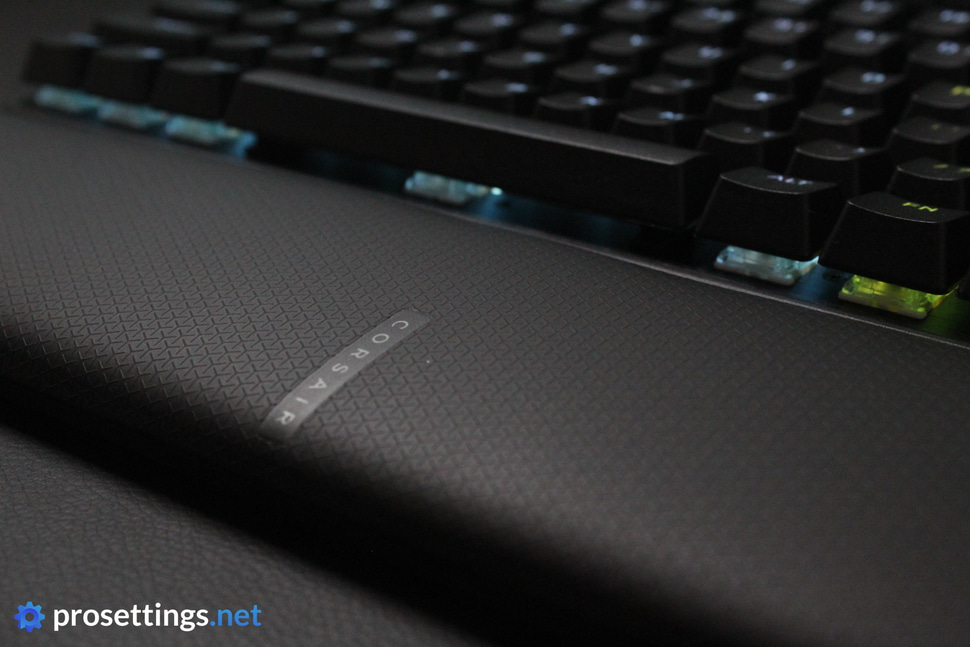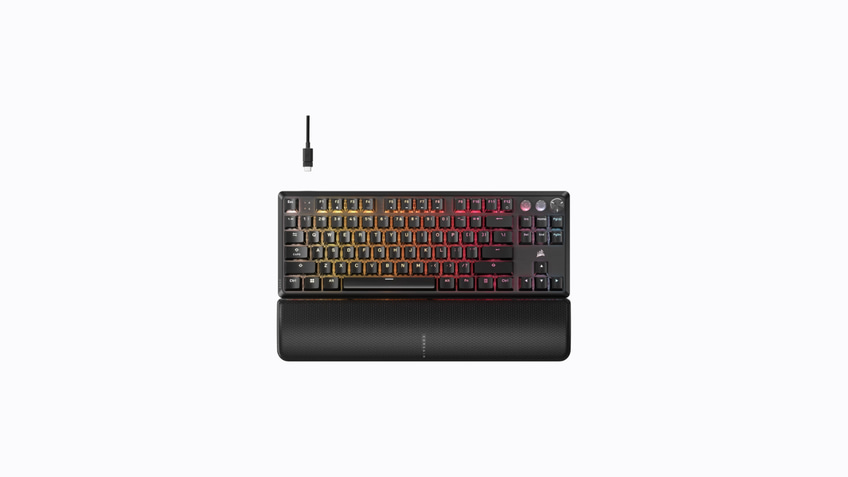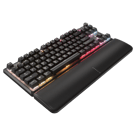For years, Corsair keyboards were prominently placed on the desks of professional gamers. In recent times, however, the brand’s market share fell, probably due to the rise of analog keyboards from other brands. It took them some time, but now Corsair have finally released a competitor to today’s top gaming keyboards, featuring their own HE switches in their well-known design style. Read our full Corsair K70 Pro TKL review to find out if this board is good enough to stand alongside today’s greatest gaming keyboards.
At A Glance
Corsair K70 PRO TKL
Used by 12 players ()Corsair’s K70 Pro TKL shows that the brand still knows how to make a high-performance gaming keyboard. It’s solidly built, sounds good for a mass-produced HE board, and delivers excellent gaming performance with features like Rapid Trigger and adjustable actuation.
Pros
- Comes with a very decent included wrist rest
- Switches feel good
- Good sound
- Good build quality
Cons
- Only the main ‘60%’ cluster of keys are HE and hotswappable, others are not
- Software is bloaty and clunky
Specs
| Form Factor | TKL |
|---|---|
| Switches | MGX Hyperdrive Switches |
| PCB | Hotswappable |
| RGB | Yes |
| Height | 4.0cm |
| Width | 44.4cm |
| Length | 16.6cm |
First Impressions
Packaging
Inside the box, you will find:
- A USB-C to USB-A cable
- A wrist rest
- The keyboard itself
- User documentation
Curiously, Corsair has done away with their slightly curved and heavily textured extra keycaps for WASD and the likes that were often found as optional extras on their high-end keyboards. I don’t really mind that, as I didn’t use those extra keycaps, but it can be good to know.

Keyboard
Important to note is that the K70 Pro TKL can be bought in two different versions. There’s one that comes with ABS keycaps and one that comes with PBT keycaps. Since the price difference is only $10, I would personally always go for the PBT version, and that’s also the one I’m reviewing here. It is cool that you get a choice, though. Most other brands don’t do that.
The board itself looks relatively sleek and subdued for a Corsair board. There’s a blacked out logo above the arrow keys and then three media keys on the top right of the board, but aside from that there’s nothing that really stands out.
Like many gaming keyboards, the K70 Pro TKL has a floating keycaps design, which means that the switches sit directly atop the case and not recessed in the case or surrounded by bezels. One major advantage of this design is that it’s a lot easier to clean, but I am personally not a big fan of the aesthetics of such boards (anymore).
What I am a big fan of is the wrist rest. Contrary to what some other brands have been doing in recent times, Corsair doesn’t seem to have subjected their wrist rests to the horrors of cost-cutting. What you’re getting here is a pleasing and soft wrist rest that attaches to the board via magnets. A classy and comfortable extra touch.
On the bottom, there’s a set of two flip-up feet that allows you to place the keyboard at an angle. Four big rubber elements help keep the keyboard in place.
RGB
The RGB on the Corsair K70 Pro TKL is, as we’ve come to expect from Corsair, extremely impressive. Different lighting effects blend seamlessly, there’s no flickering or stuttering when changing scenes, and the lights shine through evenly. I have the black version for testing, so there’s not much of that ‘ethereal glow’ when the lighting is on, but there’s also a white version available that I imagine will please the RGB fans even more.

Features and Build Quality
Materials and Design
Like a lot of Corsair keyboards, the K70 Pro TKL has a plastic case with a brushed aluminum top plate. Whether you like that style or not is entirely up to your personal preferences of course, but I like the fact that the aluminum is very dark and, as such, blends in with the black of the case. I’ve seen some images of the white version and it seems to have a noticeable difference between the plate and the case.
In terms of build quality, I don’t really have any complaints. The board feels solid and substantial. With a weight of around 1 kilogram, this definitely doesn’t feel like a cheap plastic board. When I apply pressure to the sides in order to get it to twist, nothing really happens either, so as far as I can tell this is a well-built keyboard.
Keycaps
The included PBT keycaps feel good to me. They’re not my favorites when it comes to feel (the texturing on them feels slightly too rough for me) but the letters and legends look crisp and the caps themselves are decently thick. As far as stock keycaps go, there’s not much to complain about. The font isn’t my absolute favorite, as it’s a little too ‘caps-lock like’ to me, but that’s a personal nitpick.
I did not get a version with ABS keycaps, so I cannot comment on how those feel.

Customization
Customizing the lighting and the performance of the board is done via Corsair’s iCUE. This is a very large and, to me, bloaty program, but you do get a ton of options. You could easily spend hours customizing lighting profiles alone.
Additionally, you can also program macros, rebind buttons, change what the multifunctional control dial does, and of course change the actuation point and behavior of the MGX Hyperdrive switches.
Many people take issue with iCUE, and while I can sympathize with some of them, it has to be said that there’s a lot of customization possible in this program. Plus, if you really don’t want to have iCUE installed at all times, you can just save your settings to one of 5 onboard profiles.
Switches
The Corsair K70 TKL Pro is partially powered by Corsair’s MGX Hyperdrive switches. I say ‘partially’ because only the main key cluster has Hyperdrive switches. The arrow keys, F-row, and nav cluster all have regular Corsair linear switches. Those regular switches are not hotswappable to boot. I find that to be a puzzling choice. Sure, most gamers don’t need HE switches on their F row, but it’s a bit of a silly cost-cutting measure if you ask me.
With that said: the MGX Hyperdrive switches feel good to me. They also come pre-lubed and they’re light and smooth, with a bit of a bouncy feeling to them. Obviously, a factory lubing job will almost never match the quality of hand-lubing done by an enthusiast, but I personally don’t see a reason to open these up and do anything to them.
The linear switches feel pretty similar to the MGX Hyperdrives. I rarely use the arrow keys, nav cluster, or F row (unless it’s just for one button press) so the actual sound and feeling of these switches doesn’t matter that much to me, but again: it would have been lovely if the entire keyboard used the same switches. Even if you don’t care about consistency in that way, it’s disappointing that the regular linear switches cannot be hotswapped. This means that, if a switch breaks, you’ll have to bust out your soldering iron or hope that your board is still under guarantee.

Typing and Gaming Experience
Gaming Experience
Like any modern gaming keyboard worth its salt, the Corsair K70 Pro TKL offers features like Rapid Trigger and the ability to set custom actuation points on a per-key basis. There are also other features like FlashTap, which is Corsair’s version of Snap Tap (or SOCD). Do note that this tech is banned in certain games (like CS2) so if you’ve purchased this board and find that you cannot join certain online games, make sure FlashTap is off.
The implementation of these features is solid. As far as I can evaluate, the K70 Pro TKL can go toe-to-toe with industry giants like the Wootings and Huntsmans of this world in gaming scenarios. It’s not the most advanced implementation of HE switches, though. Most of what you need is there, but if you’re into really going in-depth with the performance of Rapid Trigger, for example, brands like Wooting and Razer offer more options.
Everything that is there works perfectly well though, and the actuation range is adjustable from 0.1 to 4.0mm, which is impressive as well. The board is snappy, responsive, and absolutely elevates your gameplay when compared to a regular mechanical board.
There’s also the 8000Hz polling rate, but to me that does not make a difference for gaming at all. That’s not to say that brands shouldn’t innovate and push the envelope, but I absolutely would not be able to tell the difference between an 8000Hz keyboard and a 1000Hz keyboard. For me, this is a ‘nice to have’ feature that I’m not against, but don’t expect it to really elevate your gameplay. The switches and their features (Rapid Trigger etc.) definitely will, but the polling rate won’t.

Typing Experience
Corsair went through the trouble of adding two sound dampening foams to the case. That has resulted in a board that sounds, for a mass-produced HE keyboard, pretty good. The stabilizers on my unit sound great and the switches have a pleasing clacky sound. There’s no case ping or other unwanted noises either, which adds to the enjoyment.
Naturally, HE boards should not be your main port of call if you’re looking for a keyboard with the absolute best sound. But unless you’ve experienced high-end custom boards or you’re super sensitive to how a keyboard should sound, you’re not going to have any issues with this one.
Something that will no doubt improve the typing/productivity experience for a lot of people are the extra buttons on the top right. The dial can be reprogrammed in iCUE to do a variety of things, and the gaming mode button is a cool way of swapping profiles that feels a lot nicer than pressing a button combo. Finally, there’s also a media button. These all feel good to use and don’t feel like a cheap afterthought.

Sound Test
Alternatives
There are tons of HE boards out there at this point in time, so rather than comparing it to every single one I can think of, I will compare it to two of today’s standards. Feel free to ask in the comments if you want a comparison with other boards. I’ll happily reply and do my best to inform you thoroughly.
Corsair K70 Pro TKL vs Razer Huntsman V3 Pro TKL
Both keyboards have a very similar aesthetic. They also both come with special multimedia buttons and a wrist rest, though the K70 Pro TKL’s wrist rest feels better.
In terms of performance, both boards are pretty much impossible to separate ingame. The Razer board offers slightly deeper customization, though.
The biggest difference, to me, is in the sound. The Huntsman V3 Pro TKL is quite loud and sounds (to me) very subpar. The K70 Pro, by comparison, sounds a lot better.
See our Razer Huntsman V3 Pro TKL review
Corsair K70 Pro TKL vs Wooting 80HE
For me personally, the Wooting 80HE is today’s golden standard when it comes to gaming keyboards. To Corsair’s credit, they do come very close. The Wooting offers more in-depth customization and I far prefer their web-based Wootility customization program over Corsair’s heavy iCUE program, but in actual gaming scenarios it can be tough to separate the two.
The Wooting does look like a more unique keyboard, but beauty is very much in the eye of the beholder.
Finally, there’s the typing sound. As a whole, I’d say both boards are pretty close to each other. I personally prefer the slightly thockier sound of the Wooting over the clackier sound of the K70 Pro TKL, but objectively speaking I can’t say that one sounds way better than the other.
Read our Wooting 80HE review
Conclusion
Corsair’s K70 Pro TKL shows that the brand still knows how to make a high-performance gaming keyboard. It’s solidly built, sounds good for a mass-produced HE board, and delivers excellent gaming performance with features like Rapid Trigger and adjustable actuation. While it doesn’t offer quite the same deep customization that some competitors do, the K70 Pro TKL holds its own in gaming scenarios against today’s best analog boards.
The odd choice of mixing switch types and the lack of full hotswap support are minor faults, but in day-to-day gaming and typing, this is a seriously good board. If you want a familiar, polished Corsair board with modern analog tech under the hood, the K70 Pro TKL is definitely worth checking out.
This product was received for free from the manufacturer and given to our reviewer to test and review. Brands and manufacturers have no editorial control over our reviews. For more information, check out our review FAQ.










